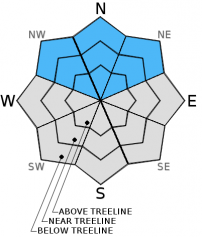| Wednesday | Wednesday Night | Thursday | |
|---|---|---|---|
| Weather: | Mostly cloudy | Cloudy with a slight chance of rain and snow after midnight. Snow level around 7500 ft. | Cloudy with a chance of rain and snow in the morning. Rain and snow becoming likely in the afternoon. Snow levels starting between 7000 and 7500 ft. and dropping to 5000 to 5500 ft. by the evening. |
| Temperatures: | 41 to 49 deg. F. | 29 to 36 deg. F. | 38 to 44 deg. F. |
| Mid Slope Winds: | Southwest | Southwest shifting to south after midnight | South |
| Wind Speed: | 15 to 20 mph with gusts to 30 mph increasing to 30 to 35 mph with gusts to 50 mph in the afternoon | 45 to 50 mph with gusts to 75 mph increasing to 55 to 60 mph with gusts to 90 mph after midnight | 60 to 70 mph with gusts to 105 mph |
| Expected snowfall: | 0 | 0 | 2 to 4 |
| Wednesday | Wednesday Night | Thursday | |
|---|---|---|---|
| Weather: | Mostly cloudy | Cloudy with a slight chance of snow after midnight | Cloudy with a chance of rain and snow in the morning. Snow becoming likely in the afternoon |
| Temperatures: | 36 to 46 deg. F. | 27 to 34 deg. F. | 36 to 42 deg. F. |
| Ridge Top Winds: | Southwest | Southwest | South |
| Wind Speed: | 25 to 35 mph with gusts to 40 mph increasing to 50 to 55 mph with gusts to 85 mph in the afternoon | 65 to 70 mph with gusts to 105 mph increasing to 80 to 85 mph with gusts to 125 mph after midnight | 80 to 85 mph with gusts to 130 mph increasing to 90 to 95 mph with gusts to 140 mph in the afternoon. |
| Expected snowfall: | 0 | 0 | 3 to 6 |























